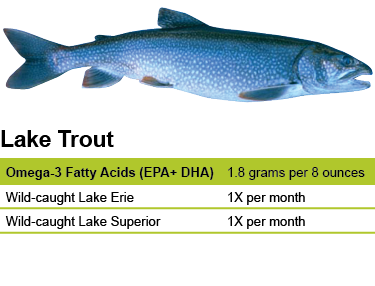BIOLOGY AND HISTORY
Lake trout were historically the top Great Lakes predator. They generally live at or near the bottom of the lake, but some may also occur in the open water, far offshore. Because they are solitary fish that hunt alone, they are more difficult to catch commercially than whitefish and yellow perch.
Lake trout may live as long as 20 years. It is the largest of all the trout; the average lake trout generally weighs 7-12 lbs., but the record fish taken from Wisconsin waters is a 47-lb. specimen caught in Lake Superior in 1946.
Historically, lake trout, along with whitefish, sturgeon and herring, were one of the “big four” species of Great Lakes commercial fishing. As early as the 1880s, lake trout numbers began declining, probably due to overfishing and pollution of their spawning areas. However, it was the invasive sea lamprey that nearly wiped out lake trout when the lamprey entered the Upper Great Lakes in the 1930s. Today, Lake Superior supports the only remaining naturally sustaining population of lake trout in the Great Lakes.
Lake trout are a favorite target of sea lamprey, eel-shaped parasitic fish that have no natural predators in the Great Lakes. Sea lamprey have been managed since 1960 by using the selective chemical TFM that kills young lamprey in streams and rivers. This keeps lamprey numbers low, but without continuous treatment the lamprey population would explode again. After TFM treatments lowered the numbers of lamprey, fisheries biologists began restocking the Great Lakes with lake trout. Some remnant wild lake trout populations in Lake Superior remained, and they eventually fully recovered. However, wild lake trout were completely eliminated from Lake Michigan. The lake trout rehabilitation program in Lake Michigan, coordinated by the Great Lakes Fishery Commission, began in 1965. Since then, 2-3 million yearling lake trout have been stocked each year, funded by the federal government. The fish grew well to adult size, but they failed to reproduce. Finally, in 2013, the Green Bay office of the U.S. Fish and Wildlife Service announced the discovery of a significant number of young and wild lake trout in several areas of Lake Michigan. It appears that lake trout are finally reproducing again in Lake Michigan. While it will still take significant effort to completely restore the population, this is an important step forward.


